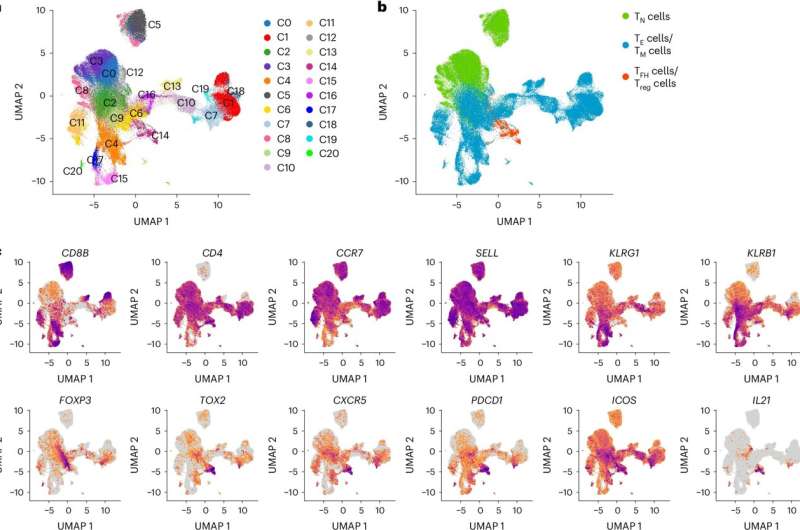This article has been reviewed according to Science X's editorial process and policies. Editors have highlighted the following attributes while ensuring the content's credibility:
fact-checked
peer-reviewed publication
trusted source
proofread
T helper cells may be the key to improving annual influenza vaccines

Scientists at St. Jude Children's Research Hospital and Washington University School of Medicine have discovered why the flu vaccine can perform poorly. They found that a specific type of immune cell, called T follicular helper cells, indirectly controls the anti-influenza response.
These helper cells often "see" the wrong parts of the virus, likely leading to immunity that is less effective. The findings, which could guide better vaccine design, were published today in Nature Immunology.
"The annual flu vaccine provides some level of protection, but it could be better," said senior co-corresponding author Paul Thomas, Ph.D., St. Jude Department of Host-Microbe Interactions. "We found that the current flu vaccine formulation could likely be improved by focusing on the influenza surface proteins and excluding the virus' internal proteins that distract the immune system."
Findings showed that the annual flu vaccine raises vaccinated individuals' immune responses, but often not towards the most beneficial proteins. The best anti-flu responses target the two influenza surface proteins, hemagglutinin and neuraminidase, which change year to year.
Scientists try to adapt the vaccine annually to account for the new surface proteins on the dominant flu strains, while the rest of the formulation remains constant. Less than ideal immune responses were caused by the vaccine targeting unchanging internal proteins, rather than the more beneficial surface proteins.
"In the current standard flu vaccine, we have this mix of other proteins that we may not need to be in there," Thomas said. "New vaccine formulations should focus the T-cell response on just the surface proteins. An easy way to do that is by only giving immune cells those surface proteins to look at, by removing those other off-target peptides."
Looking in lymph nodes brings lack of immunity to light
Previous research has hinted at why the influenza vaccine has such varied effectiveness, but this study provides a much clearer mechanism. The ideal immune response against the flu involves antibodies. Antibodies bind to targeted proteins to both prevent their function and attract immune cells. B cells make antibodies, but they do not decide what to target.
A different group of immune cells, called T follicular helper cells, activate B cells in lymph nodes. This study is the first to offer a high-resolution perspective of helper cells taken from the lymph nodes of people who received the flu vaccine, revealing new insights into how these T cells do or do not direct effective immunity to influenza.
"Most studies look at blood, which is easy to sample, but not where the main T-cell response happens," said co-first author Stefan Schattgen, Ph.D., St. Jude Department of Host-Microbe Interactions. "We were able to get a better view by looking at lymph nodes directly over time."
To look at the immune response to vaccination, the scientists examined lymph node samples from a small group of study participants over the course of two years. The researchers identified the pieces of viral protein to which the follicular helper T cells responded, revealing their preference for internal proteins.
"We found that a large group of T follicular helper cells are responding to the same proteins that they see every year, instead of targeting the surface proteins that we update and want them to target," Thomas said.
Locking in the faulty response in the lymph node
The researchers documented how the immune cells in lymph nodes respond to the vaccine, which contrasted with prior research and revealed a new piece of the mechanism underlying poor vaccine performance.
"In blood we only see a small, quick blip of an anti-flu T-cell response, but in lymph nodes, it can stay for months," Schattgen said. "This 'locks in' the anti-flu immunity. So, if we start with an immune response against the wrong target, it can stay 'stuck' on that internal protein instead of the novel surface proteins."
Together, the findings show that annual influenza vaccine performance can be hindered by an immune response against the wrong proteins, those in the vaccine that are conserved from year to year. Keeping that incorrect immunity long-term prevents the body from creating new, more effective antibodies.
This mirrors a well-known immunological phenomenon called antigenic original sin or imprinting, when a person mounts an inappropriate immune response to an influenza infection due to a previous flu exposure.
"We're finally getting at the underlying mechanism of what antigenic original sin actually is," Thomas said. "It was advanced by Robert Webster many years ago that the process involved B cells. We've now shown T follicular helper cells are likely part of the imprinting process that commits B cells to recall a memory response preferentially."
With the knowledge of what makes the influenza vaccine less potent in some people, the researchers hope to find ways to use that new understanding to increase vaccine efficacy.
"It's fascinating that we're still learning a lot about how influenza vaccines work in terms of the human immune response," Thomas said. "And it's exciting to show there are still new ways that we can improve these vaccines and provide better protection."
More information: Stefan A. Schattgen et al, Influenza vaccination stimulates maturation of the human T follicular helper cell response, Nature Immunology (2024). DOI: 10.1038/s41590-024-01926-6




















